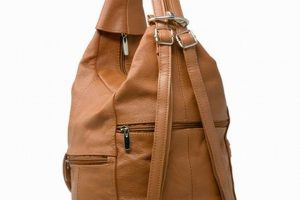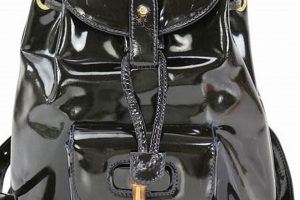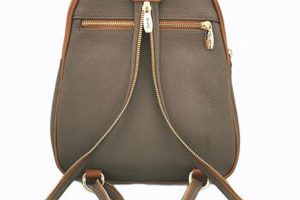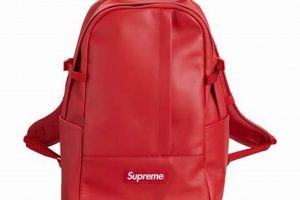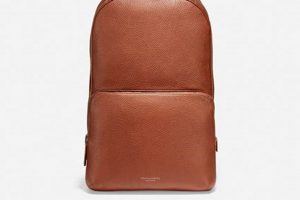Bags crafted from real animal hide and designed to be carried on the back represent a specific segment within the broader market for carrying solutions. These items are often characterized by their durability, aesthetic appeal, and perceived value. For example, a student might choose such a bag for its longevity and resistance to wear and tear, while a professional might select one for its sophisticated appearance.
The advantages of using these products include their robustness, which makes them suitable for carrying heavy loads and withstanding daily use. Their natural material lends a certain elegance and often develops a desirable patina over time. Historically, the use of animal hides for carrying goods dates back centuries, evolving from simple pouches to more complex and specialized designs. The perceived quality and status associated with items made from this material contribute to their enduring popularity.
The following discussion will delve into the different grades of leather used in the manufacturing process, explore various design elements and features, and provide guidance on proper care and maintenance to extend the life of these valuable items.
Genuine Leather Backpacks
The subsequent points offer guidance on selecting, utilizing, and preserving items constructed from real animal hide and designed for carrying on the back. Adherence to these recommendations will enhance the overall experience and extend the lifespan of the product.
Tip 1: Material Assessment: Prior to acquisition, meticulously scrutinize the quality of the leather. Full-grain leather, being the highest grade, offers superior durability and aesthetic appeal. Top-grain leather, while still of good quality, may exhibit imperfections. Bonded leather represents a lower grade and may not possess the same longevity.
Tip 2: Stitching Examination: The integrity of the stitching is paramount. Reinforcements at stress points, such as the straps and base, are essential. Double stitching indicates enhanced durability and resistance to tearing.
Tip 3: Hardware Evaluation: Zippers, buckles, and clasps should be constructed from durable materials like solid metal, not plastic. Smooth operation of zippers and secure fastening of buckles are critical factors.
Tip 4: Weight Distribution Considerations: When loading, distribute weight evenly to prevent undue strain on specific areas of the bag. Avoid overloading, as this can compromise the structural integrity and accelerate wear and tear.
Tip 5: Protection from Elements: Real animal hide is susceptible to damage from water and excessive heat. Employ protective sprays or conditioners designed for leather to repel moisture and prevent cracking.
Tip 6: Regular Cleaning Protocol: Establish a routine cleaning schedule, using a soft cloth and specialized leather cleaner. This removes dirt and grime, preserving the material’s appearance and preventing deterioration.
Tip 7: Proper Storage Techniques: When not in use, store the item in a cool, dry place, away from direct sunlight. Stuffing the bag with acid-free paper helps maintain its shape and prevents creasing.
Tip 8: Professional Maintenance: Periodically, consider professional leather conditioning and repair services. Trained technicians can address minor damage and restore the material’s suppleness and appearance.
Implementing these strategies ensures the sustained performance and aesthetic value of these goods. Careful selection, responsible usage, and consistent maintenance contribute significantly to maximizing the investment.
The succeeding section will explore various design considerations and stylistic elements relevant to the purchase and enjoyment of quality bags for carrying on the back.
1. Leather Grade
Leather grade is a fundamental determinant of quality, durability, and overall value in bags crafted from real animal hide and designed to be carried on the back. The specific grade employed in manufacturing dictates the product’s resistance to wear, aesthetic characteristics, and expected lifespan. Understanding the nuances of each grade is essential for informed purchasing decisions.
- Full-Grain Leather
Represents the highest quality, derived from the top layer of the hide, retaining all natural grain. Its tightly packed fibers offer superior strength and resistance to abrasion. Over time, it develops a rich patina, enhancing its aesthetic appeal. Bags utilizing this grade are typically more expensive, reflecting their durability and longevity.
- Top-Grain Leather
A step below full-grain, this grade has had the outermost layer sanded to remove imperfections. While still durable, it lacks the inherent strength and natural grain of full-grain. It is often coated to provide a more uniform appearance and greater stain resistance. This grade offers a balance between quality and cost.
- Split-Grain Leather
Created from the fibrous part of the hide, after the top-grain has been separated. It is typically coated with a polymer to create a more uniform surface. Split-grain is less durable and more prone to stretching and tearing than full-grain or top-grain. Suede is a type of split-grain leather.
- Bonded Leather
The lowest grade, composed of leather scraps and fibers bonded together with adhesives. It often receives an artificial grain pattern and finish. Bonded leather offers limited durability and is susceptible to cracking and peeling. While more affordable, its lifespan is significantly shorter compared to higher grades.
The selection of an appropriate leather grade for bags crafted from real animal hide and designed to be carried on the back involves a careful consideration of budget, intended use, and desired lifespan. While full-grain represents a significant investment, it delivers unparalleled durability and aesthetic appeal, justifying its higher cost for discerning consumers. Understanding these differentiations enables informed consumers to make choices aligned with their particular needs and financial parameters.
2. Stitching Strength
The integrity of stitching within bags crafted from real animal hide and designed for carrying on the back directly influences their load-bearing capacity, resistance to wear, and overall longevity. Deficient stitching, characterized by weak threads, loose loops, or inconsistent spacing, initiates points of failure under stress. Conversely, robust stitching, achieved through high-tensile threads, tight seams, and reinforced stress points, ensures the structural integrity of the bag. As an example, consider a student’s bag laden with textbooks; inadequately stitched straps are prone to tearing, rendering the bag unusable.
The selection of appropriate stitching techniques and materials is crucial for manufacturers. Lockstitch sewing, wherein each stitch interlocks independently, prevents unraveling even if a thread breaks. Reinforcements at key areas, such as strap attachments, zipper junctions, and corners, distribute stress more evenly and mitigate the risk of tearing. Heavy-duty nylon or polyester threads exhibit superior resistance to abrasion and degradation compared to cotton threads. Furthermore, consistent stitch density and seam allowance adherence ensure uniform stress distribution across the bag’s structure. For instance, military-grade carrying solutions, designed for extreme conditions, mandate stringent stitching specifications to withstand substantial loads and harsh environments.
In summary, stitching strength is a critical, albeit often overlooked, determinant of a bag’s performance and durability. Substandard stitching undermines the inherent strength of the leather itself. A well-constructed bag integrates robust stitching as an integral component, safeguarding against premature failure. Consumers benefit from scrutinizing stitching quality during the purchase process, while manufacturers bear responsibility for implementing rigorous quality control measures to ensure lasting structural integrity. Understanding the relationship between stitching strength and overall bag performance is essential for both consumers and producers in the realm of real animal hide goods for carrying on the back.
3. Compartment Design
The arrangement of internal divisions and external pockets, termed “compartment design,” significantly impacts the functionality and user experience of bags fashioned from real animal hide and designed for carrying on the back. The presence, size, and accessibility of these compartments directly influence the organization and protection of carried items. A poorly conceived arrangement can lead to inefficiencies, such as difficulty locating specific articles or inadequate protection for delicate items. For example, a bag lacking a dedicated, padded laptop compartment exposes the device to potential damage from impacts or pressure, negating the inherent durability of the leather exterior.
Effective compartment design considers the anticipated use case. A bag intended for daily commuting might prioritize a readily accessible compartment for quick retrieval of a transit pass or mobile phone. A travel-oriented design could incorporate multiple internal compartments to separate clothing from toiletries or electronics. The strategic placement of zippered pockets and secure closures further enhances the safety and organization of contents. Furthermore, the choice of lining materials within compartments contributes to the protection of sensitive items, such as preventing scratches on eyeglasses or damage to electronic screens. The physical dimensions of each compartment should also be meticulously calibrated to accommodate commonly carried objects, avoiding excessive wasted space or restrictive confines.
In conclusion, compartment design is not merely an aesthetic consideration; it is a critical determinant of the practical utility and user satisfaction associated with bags crafted from real animal hide and designed for carrying on the back. Thoughtful compartment layouts maximize organizational efficiency, protect carried items from damage, and ultimately enhance the overall value proposition of these goods. Manufacturers who prioritize this element in the design process offer a more compelling and functional product to consumers seeking a balance of style and practicality.
4. Hardware Quality
The selection and implementation of hardware elements within bags fashioned from genuine animal hide and designed for carrying on the back significantly influence the overall performance, longevity, and perceived value of these items. Hardware components, encompassing zippers, buckles, clasps, and strap adjusters, are subjected to repetitive use and mechanical stress, necessitating materials and construction methods that ensure durability and functionality.
- Material Composition
The material used to construct hardware components dictates their resistance to corrosion, breakage, and deformation. Solid brass or stainless steel hardware exhibits superior durability compared to zinc alloy or plastic alternatives. For example, a brass buckle resists corrosion from exposure to moisture and sweat, maintaining its structural integrity over time. Conversely, a plastic buckle is prone to cracking or breaking under stress, compromising the bag’s security and usability.
- Zipper Mechanism
Zippers are a critical point of potential failure in a bag. High-quality zippers feature smooth, reliable operation and robust teeth that resist separation under pressure. Metal zippers, such as those manufactured by reputable brands known for their quality, generally provide greater durability than plastic coil zippers. A well-constructed zipper allows for effortless opening and closing, preventing snags and ensuring the secure closure of compartments.
- Strap Adjustment Systems
Strap adjusters enable users to customize the fit of the bag, distributing weight evenly and maximizing comfort. Durable metal adjusters, securely attached to the straps, maintain their position without slipping. Conversely, plastic adjusters are prone to breaking or loosening, requiring frequent readjustment and potentially compromising the bag’s carrying capacity. The design of the adjuster should also prevent abrasion or damage to the straps themselves.
- Reinforcement and Attachment
The manner in which hardware components are attached to the leather bag impacts their long-term stability. Rivets or reinforced stitching at stress points prevent hardware from tearing away from the leather. For instance, a buckle that is securely riveted to the bag’s flap can withstand significant pulling forces without detaching. Insufficient attachment methods, such as weak stitching or inadequate rivets, increase the likelihood of hardware failure and necessitate repairs.
The integration of high-quality hardware components is paramount for ensuring the long-term functionality and user satisfaction associated with bags crafted from genuine animal hide and designed for carrying on the back. Investing in superior hardware materials and construction techniques enhances the durability of the bag, mitigates the risk of component failure, and reinforces the overall perceived value of the product.
5. Long-term Care
The longevity and aesthetic appeal of bags crafted from real animal hide and designed for carrying on the back are directly proportional to the diligence applied to their long-term care. Neglecting proper maintenance accelerates deterioration, diminishing both the functional lifespan and visual characteristics of these articles. A consistent and informed care regimen is therefore essential for preserving their value and utility.
- Regular Cleaning and Conditioning
Periodic removal of surface dirt and the application of leather conditioners maintain the material’s suppleness and prevent cracking. Accumulated dirt particles act as abrasives, gradually damaging the surface. Leather conditioners replenish natural oils lost over time, preserving the material’s flexibility and preventing dryness that leads to fissures. A bag subjected to regular cleaning and conditioning retains its original texture and color for an extended period, while a neglected bag becomes brittle and prone to discoloration.
- Moisture Protection
Real animal hide is susceptible to damage from excessive moisture. Prolonged exposure to rain or humidity can cause swelling, staining, and the growth of mold or mildew. Employing water-repellent sprays or waxes creates a protective barrier, preventing moisture from penetrating the material. Immediately drying a wet bag with a soft cloth minimizes the risk of permanent damage. A protected bag maintains its structural integrity and aesthetic appearance in damp environments, while an unprotected bag may develop unsightly stains and weaken over time.
- Proper Storage Techniques
The method of storage significantly impacts the preservation of a bag when not in use. Storing a bag in a dust-free environment, away from direct sunlight and extreme temperatures, prevents fading, cracking, and distortion. Stuffing the bag with acid-free paper helps maintain its shape and prevents creasing. Avoid storing the bag in plastic bags, which can trap moisture and promote mold growth. A properly stored bag retains its shape, color, and texture, while an improperly stored bag may become misshapen, faded, or damaged.
- Professional Repair and Restoration
Addressing significant damage or wear through professional repair and restoration services extends the lifespan of a bag. Trained leather technicians can repair tears, replace hardware, and restore color with specialized techniques and materials. Ignoring significant damage accelerates deterioration and potentially renders the bag unusable. Professional restoration can revive a worn or damaged bag, restoring its functionality and aesthetic appeal. Timely intervention prevents minor issues from escalating into irreversible damage.
The effectiveness of long-term care is reflected in the enduring quality and appearance of bags crafted from real animal hide and designed for carrying on the back. Diligent application of appropriate care practices safeguards the investment and ensures continued enjoyment of these durable and aesthetically pleasing items.
Frequently Asked Questions
The following section addresses common inquiries regarding items made from real animal hide and constructed for carrying on the back, providing concise and factual responses to assist in informed purchasing and usage decisions.
Question 1: How does the grade of leather affect the durability of bags crafted from real animal hide and designed for carrying on the back?
The leather grade is a primary determinant of durability. Full-grain leather, derived from the top layer of the hide, offers the greatest resistance to wear and tear due to its tightly packed fibers. Lower grades, such as split-grain or bonded leather, are significantly less durable and more susceptible to damage.
Question 2: What are the key indicators of quality stitching in real animal hide bags for carrying on the back?
Indicators of quality stitching include the use of high-tensile threads (e.g., nylon or polyester), consistent stitch density, reinforced seams at stress points (e.g., strap attachments), and the employment of lockstitch sewing, which prevents unraveling.
Question 3: What precautions should be taken to protect real animal hide bags for carrying on the back from water damage?
Protection measures include the application of water-repellent sprays or waxes specifically designed for real animal hide, immediate drying with a soft cloth after exposure to moisture, and avoiding prolonged exposure to rain or humidity.
Question 4: How should bags crafted from real animal hide and designed for carrying on the back be stored when not in use?
Proper storage involves placing the bag in a cool, dry environment, away from direct sunlight and extreme temperatures. Stuffing the bag with acid-free paper helps maintain its shape and prevents creasing. Storage in plastic bags should be avoided to prevent moisture accumulation.
Question 5: What is the purpose of leather conditioning for bags crafted from real animal hide and designed for carrying on the back?
Leather conditioning replenishes natural oils that are lost over time, preserving the material’s suppleness, preventing dryness, and minimizing the risk of cracking. Regular conditioning extends the lifespan and maintains the aesthetic appearance of the bag.
Question 6: Can damaged bags crafted from real animal hide and designed for carrying on the back be effectively repaired?
In many instances, damage can be effectively addressed through professional repair and restoration services. Trained technicians can repair tears, replace hardware, and restore color using specialized techniques and materials. Timely intervention prevents minor issues from escalating into irreversible damage.
In summary, proper care, storage, and occasional professional maintenance are essential for maximizing the lifespan and maintaining the aesthetic appeal of bags crafted from real animal hide and designed for carrying on the back.
The following section will offer concluding remarks on the selection, usage, and care of bags crafted from real animal hide and designed for carrying on the back.
Genuine Leather Backpacks
This exploration of bags crafted from real animal hide and designed for carrying on the back has underscored several critical considerations. The material grade dictates durability, stitching integrity ensures structural soundness, compartment design optimizes functionality, hardware quality guarantees reliable operation, and consistent maintenance prolongs lifespan. Neglecting these factors diminishes the value and utility of this product category.
Therefore, the informed selection, conscientious usage, and diligent care of bags crafted from real animal hide and designed for carrying on the back are paramount. By adhering to the principles outlined herein, users can maximize their investment, ensuring both lasting performance and enduring aesthetic appeal. The discerning consumer recognizes that quality represents not merely a cost, but an enduring value.


